John D. Meyer, Old Mechanical Penny Banks, 1952 Handbook, Banks 16-30
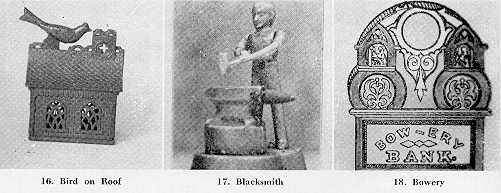
No. 16. Bird On Roof — Of a church building. Put the coin in the comb on the head of the bird. Pull a lever and the bird sitting on top of roof leans over and deposits the coin in the chimney of building. March 5, 1878. Building is 3 x 4 inches and 5 inches high to top of chimney. Windows ad doors are of open work and the roof has a graceful slope. $155.00 ($35.00 in 1939)
No. 17. Blacksmith — The blacksmith stands at his anvil and the coin when placed in the slot is driven into the anvil by a blow from the hammer in the hands of the blacksmith, when the pointed end of the anvil which acts as a lever, is pushed down. While this bank was patented by Frederick Plattner and a sample made it was never produced commercially. 804430, November 14, 1905. Made in Cleveland but never reached production stage. $xxxxxx
No. 18. Bowery Bank — Two dogs dressed up nod their heads at the windows when coin is dropped into the slot. The name "Bowery Bank." This bank has wooden and paper works inside, outside is cast iron. The dogs are dressed up, one as a "Dude" of the eighties with the high collar and tie, with the features of popular Pug Dog of those days and the other one with his high hat and monocle has the features of a Collie. Selchow & Richter in 1890 catalogue offer these banks at $4,00 per dozen. $xxxxxx
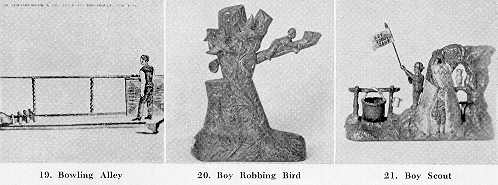
No. 19. Bowling Alley — Man bowls and knocks down the tenpins and bell rings. This bank is advertised in some old catalogues as the "Ten Pin Alley Bank." In Oscar Strasburger Catalogue called "Bowling Alley" bank. Size 11-1/2" x 6-1/2". A rare one. 222058. November 25, 1879, by Kyser & Rex, Philadelphia. $xxxxxx
No. 20. Boy Robbing Bird’s Nest — Boy climbs out on a limb of tree after the bird’s nest and when spring is released the limb falls down and pushes coin into the trunk. Old catalogue calls this the "Tree Bank." Stevens. Designed by Chales Bailey. $85.00
No. 21. Boy Scout — This represents a camp of the Boy Scouts, showing tent, fire, kettle, etc. Press the lever and a boy scout in full uniform waves a flag with words "Boy Scout Camp" on it. Not such a old bank but you will have to look around some to find one. This bank probably has as much appeal to the youngsters of today as any bank in your collection. Stevens. $65.00 ($8.00 in 1939)
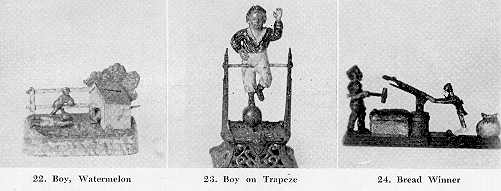
No. 22 Boys, Stealing Watermelons — Little dog come out of little dog house after them. One boy is lying flat on the ground and the other is climbing over the fence. When boy reaches for a watermelon the dog charges. A nicely decorated bank. The base represents a field of the watermelon vine and green watermelon are plainly visible. $75.00 ($20.00 in 1939)
No. 23. Boy On Trapeze — Coin is placed in the top of the boy’s head. When he revolves on the bar the coin is deposited in the base, which is very ornately made. The boy is perfectly balanced on the bar. Old advertisement says: "By putting one cent in the top of boys head he revolves once, for a five cent piece turns twice and for a quarter three times." Originally called "French’s Automatic Toy Bank." Manufactured by J. Barton Smith Co. Phila. $50.00
No. 24. Bread Winner — A political propaganda bank with these wordings thereon: "Send the Rascals Up," "Boodle-Steal-Bribery," "Bread Winners Bank" "Honest Labor Bread." Place coin on end of club, raise hammer, press lever and Labor strikes Monopoly, sending "The Rascals Up" and coin falls into loaf of bread. Length 11", height 5-1/4", width2-3/4". (In 1887 this bank could have been bought twelve for eight dollars and fifty cents, but not now.) $300.00
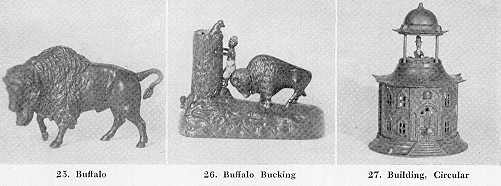
No. 25. Buffalo — Called "Trick Buffalo Bank." Twist tail a certain way and head unlocks and comes off. Made of iron 9-1/2" long and 6" high. $100.00
No. 26. Buffalo, Bucking. The buffalo standing on base painted green, butts a small negro boy dressed in bright colors up a tree stump. A very small bear cub or coon is sitting on top of the stump watching. The coin placed in slot on top of stump falls in when lever is pressed. "Patent applied for" on bottom of bank. March 20, 1888. 379,607. Patented by Alfred C. Rex. $135.00
No. 27. Building, Circular — Building with Cupola. When the lever is pressed the cupola rises exposing a little man with high hat rocking back and forth waiting to receive the coin. In this bank the slot for the coin is not visible until after the cupola has been raised and the little man appears with out-stretched hands. January 27, 1874. 146755. $200.00
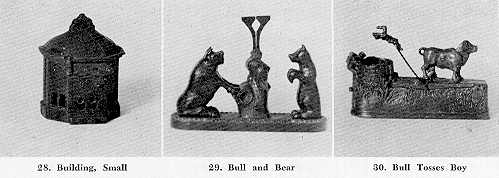
No. 28. Building, Small — Small eight-sided, three inches in diameter and four inches high. Pull out a triangular drawer at the front which receives the coin, and springs shut when released. Possibly designed to represent a bank building as there are two steps leading up in front. $25.00
No. 29. Bull and Bear — The stock market bank. Place coin in contrivance in middle of bank between the Bull and the Bear. Sometimes the coin goes into the head of the Bull, sometimes into the head of the Bear, depending on condition of the stock market. Name "Bull and Bear" Bank on base. One of the largest and heaviest banks. $175.00
No. 30. Bull Tosses Boy — Base is seven by two inches and one and three-fourth inches high. At one end is a well with a boy wearing a soldier’s cap looking down into it. At other end is a boy with upraised arms running away from the bull which charges with head down after the boy and throws him back over his head into the well. When the lever is pressed to bring about the above action the coin drops into the well ahead of the boy. $125.00
